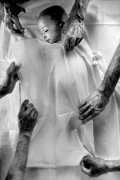
Short "Research Lab" essay, looking at the form and content of a work of art in response to Susan Sontag's "Against interpretation". I possibly took Sontag a bit too literally but on the whole I'm happy enough about this text to publish it here three years later.
A non-abstract piece of visual art has a form we are allowed or expected to interpret as relating to or depicting something else. It has intended associative content. A press photo is by definition a piece of art with content. It tells or accompanies a story and the viewer will almost always be informed or expect to be informed about the context. Press photos raise interesting questions about where the boundary between the inherent (intended?) content and our interpretation of it is. In the impressions above I have deliberately tried to peel off the layers of impressions but I can not tell whether I have reached beyond the photographer's intended content.
At times the use of terms such as form and content seems to mirror the binary opposition between the terms mind and body. Sontag's "erotics of art" seems to imply something in this direction, about "form" being something explored with the senses rather than with the mind. Of course the processing of sensual impressions is also a mental effort, so the definition does not make complete sense. In the experimental four "layers" of description above, is really the one least concerned with content the one that gives the best description of the form? There may be several "layers" or aspects to form as well as to content, form as technique, form as perfection of execution, form expressed in analytical terms such as "symmetry". There are aspects to content such as "similarity", intended content, connoted content etc.
It is a rather odd and very mental effort to try to analyse such a picture without considering its content - there is certainly nothing "erotic" about the perception of grey dots - and I believe it goes to show that at least in this case there is no purpose in looking at form and content separately - or maybe the point is that what you are left with when trying to ignore "the content" may not be "the form".